Dana 44 Solid Axle Swap
by Randall Dorn

Shortly after returning from Moab, Utah in the Summer of 2001, I decided that I was going to bite the bullet and go with a solid axle swap, or live axle conversion. The 1991-1994 Ford Explorers were equipped with Dana 35 TTB, or Twin Traction Beam, suspensions, that, in my opinion, leave much to be desired. The pivot points in the middle of the TTB are flex-killers; and if you have any plans of doing any serious rockcrawling, the TTB has to go. The Dana 35 is also equipped with weak aluminum bearing caps. With that said, the solid axle swap provides other benefits besides just flex and articulation. It also provides superior strength, more stability, and tends to stay in alignment much more so than any independent suspension could, which also serves to decrease tire wear. The downsides to such a swap are of course the expense, and a harsher ride. It is said that solid axles ride much rougher than independent suspensions, but that can be compensated for by softer springs and shocks.
The most important thing you need to know before you attempt any kind of modification of this scale is that you can never have enough information. Do plenty of research before making even your first parts purchase. You'll be happier in the long run if you know what you are getting yourself into ahead of time. Modifications of this scale have two things in common: they are not cheap, and they are more involved than you think. Do plenty of research so that you know what to expect time-wise, labor-wise, and financial-wise. This is far from an exhaustive source of information. Do yourself a favor and find some more. Realize also, that your swap will likely be very different than mine, due to changes in what you may feel is necessary for your vehicle. This is only a guideline, please treat it as such.
I heard about the benefits of altering my front suspension initially through the , where up to now several members have swapped in solid axles beneath their Explorers or Rangers. Much of the information you see here was gathered by myself from these members, which include Tom Davis, Kampy, Riffman, Dale Tiessen, Knut Orloff, and Rick Horwitz. I may or may not be forgetting someone, my apologies if that is the case. All of these people have in common that they chose Dana 44 solid axles from early model Fords to adapt to their rigs. After hearing much of their positive feedback after performing their swaps, I was convinced that this was the route I needed to take. I have to admit, however, that the deciding factor in my decision was so that I could run an Oxlocker under my rig. I'll talk more about this piece of equipment a little later.
Choosing an Axle:The solid axle that I chose came out of a 1979 Ford Bronco. I am of the opinion that the best axle to look for, in my situation at least, was a solid Dana 44 axle from a 78-79 Ford Bronco or F-150. Both of these vehicles are full sized, which means that the axle would have to be cut down before it could be placed under my vehicle. This is still preferable to taking a Dana 44 from an older Bronco, which was very close in size to the Explorer. This is because the early model Bronco's, known as Early or Classic Bronco's, were equipped with low pinion front axles, whereas the full-size Bronco introduced in 1978 was high pinion, which is also known as 'reverse cut.' What this means is that the point on the differential where the pinion connects was below the axle tube in early year Bronco's, and the 78-79 Bronco's pinion met the differential above the axle shaft center line. In practical terms, this means that the driveshaft angle is greatly reduced by installing a high pinion axle in your front end, which is greatly exaggerated by lifted trucks, which further increases this angle. The high pinion differential also providesbetter ground clearance, for both the differential and the driveshaft. Extreme driveshaft angles can lead to binding and eventual part breakage. This is not as much a problem in the rear of a vehicle as it is in the front, because the increased driveshaft length in the rear serves to reduce the driveshaft angle to manageable levels. It is possible to cut the axle tubes and re-weld a low pinion differential in an upward degree that would place the pinion at the same angle as the incoming driveshaft. This is not desirable, however, as it leaves the ring gear inside the differential inadequately soaked in gear oil, which could lead to premature equipment failure. Also, in 1977 Ford Bronco's began to be equipped with front disc brakes, which of course is more desirable than drums. Companies such as Dynatrac and Currie can make axles to your custom specifications if the task of preparing a used one is not desirable. Be prepared however, as these custom axles are not cheap.


Choosing a running width:Choose a running width that is right for you. In my opinion, it is best to have the front axle width match closely that of the rear axle. If swapping both axles out of a donor vehicle you may decide that the width does not need to be modified for your application. In my case, that would mean running full size axles under a smaller sport utility vehicle. The axle that I acquired from the 1979 Bronco measured a full six inches wider than the axles under my Explorer. By running the axles full width, you will save on the cost of cutting them down, which runs close to $200 per axle housing, as well as $55 dollars per axle shaft. You would, however, still find expense in that new spring perches would need to be fabricated to match the springs up to your frame, or by finding some way of mounting all of your vehicles spring hangers outboard of the vehicles frame. Mounting the radius arms this way is much weaker than having the brackets mounted under the frame. The advantage in running full-width axles is that your center of gravity is effectively lowered, which helps to offset the effects of lifting. This results in a more stable vehicle that is more difficult to roll, and also allows for larger tires. The disadvantages are an increased turning radius, a loss of mobility, and the inability to fit on some trails.
Cutting down the Axle:For my application, I decided to cut the axle down 5.85 inches on the passenger side.; Cutting by this amount allows me to install an Early Bronco axle shaft in the event that mine were to break. It is much cheaper to use a shaft from a stock vehicle than to have one custom made. A stock Explorer's axle width is 58.3"; and the full-size Bronco axle width is 65.25"; Cutting 5.85"; out of the passenger side leaves me with a 59.4"; axle width, which is 1.1"; wider than the Explorer axle.; I could cut the axle down to the Explorer dimensions, but the added inch will help with the driveshaft angle, since the differential on the big Bronco's are slightly more toward the passenger side than the differential on the Dana 35 Explorer axle. The passenger side inner axle shaft on a full-size Bronco measures out to be 33.91" and the inner shaft from an Early Bronco is 28.06"; The difference between the two is 5.85 inches, which is how much I had cut from the full-size shaft to accept those from the Early Bronco. When cutting the axle shaft, it is better to send the shaft somewhere to get it cut and re-splined. Do not cut the axle shaft in the middle and re-weld it, as this leaves a weak point in your driveline. There are various companies that can do this for you, such as Moser Engineering and Dutchman Axles. I used Dutchman Axles, and the cost was $55 dollars.
Matching up the Rear:Most Dana 44 solid axles come equipped with a 5 lug, 5-1/2 inch lug configuration. The stock bolt pattern on the Explorer is a 5 lug 4-1/2" configuration. Unless I wanted to worry about carrying two spares, the rear axle bolt pattern needs to match up to that of the front. The Dana 44 was only offered briefly with a 4-1/2"; lug spacing in Dodge vehicles, but this system is less than desirable for its vacuum hub design, and its smaller parts are much weaker than the 5-1/2" axles that could be found on most Fords and Jeeps. This leaves only the option of converting the rear axle to the same bolt pattern as the new front axle. This of course, will require the purchase of new rims with the correct bolt pattern. I went with AE589 15x10 wheels mounted with 35x1250x15 BFG AT/KO's for my street tires, with plans of mounting 36x1250x15 TSL SX's for my offroad set. The stock axle shafts in the Ford 8.8"; are just barely too small in diameter to simply be re-drilled to the new pattern. This requires that the axle shafts be replaced in their entirety. Moser Engineering and Dutchman Axles offer 5 lug on 5-1/2'; bolt pattern along with new axle shafts. Dutchman Axles will run about $240, Moser $295. In addition to matching up the rear bolt pattern, the new height of the front suspension will require you to raise the rear end to match. I used Mountain Offroad spring perches and warrior shackles along with flipping the stock springs over the axle to get the required height. It is a little short in the rear now, so I plan on adding some two inch leaves and replacing the extended shackles with the stock shackles.
Gears:Besides worrying about just the bolt pattern, it is imperative that the gear sets in the front and rear match as closely as possible. It is generally acceptable to run with a difference in gears of no more than 1%, so a ratio of 4.09 in the front and 4.11 in the rear is acceptable. In my case, since I am going with 35 inch tires with the possibility of moving up a size or two later on, I chose 4.88's for the rear, and 4.89's for the Dana 44. Any difference larger than this, such as running 4.10 gears in the front with the stock 3.73's in the rear, will cause binding in the driveline, and something has to give. In most cases, this is the transfer case. Choosing a gear ratio is important, because you want something that will leave your engine running at its optimum RPM level, to maintain fuel economy and power. I would recommend purchasing the master install kits anytime you buy gears, which is really more of a rebuild kit, to help lengthen the life of your differentials and gears. After adding the 4.88 gears with the 35 inch tires, I got about 16 miles to the gallon.
Differentials:For differentials, I went with a Powertrax No-Slip in the rear, and an OxLocker in the front Dana 44. These units are both what are referred to as 'lockers. A locker allows for both axle shafts on an axle to make sure that an even amount of power is transferred to each tire. The way that most vehicles are setup from the factory is with open or limited slip differentials, which transfer all of the axles power to the tire that has no traction. This is not desirable when traveling offroad, because one or more tires may not be touching the ground at any one time. When this happens with the stock setup, the tire that is in the air gets all of the power, effectively making the vehicle stuck.
This effectively makes even a 4x4 truly only a two wheel drive vehicle, one in front and one in the rear. Only with a locking differential setup in the differentials of both axles can the full capabilities of a four wheel drive system be realized. For any serious offroading, lockers are highly desirable, the question is only on choosing one that works for you. I have to admit, the deciding factor in my converting to a Dana 44 solid axle was the fact that the OxLocker was soon going to be available for a Dana 44. The OxLocker is a selectable locker much like the ARB air lockers, which run on electricity and are turned off and on by an on board air compressor. I have no previous experience of my own concerning the air lockers, but everyone I know that has used one has had too may problems for me to feel comfortable using one. It is just too complicated, and has too many components that could fail.
However, I still wanted a selectable locker in the front, because having a full locker in the front makes turning difficult, as it tends to try to push the truck straight instead of turning. The OxLocker looks to be a much beefier locker than the ARB. The ARB is made of small spider gears and complicated moving parts that allow it to lock and unlock, but the OxLocker consists of only a massive casing and a shift fork that works by using a cable that runs through the Ox differential cover that comes with the unit. The cable runs to a switch that you can place anywhere you want inside the vehicle, which you can use to turn the locker on or off. Originally this unit was only available for Jeep Dana 30 axles, and when I heard that they were soon going to be releasing the OxLocker for the Dana 44, I decided that the time was right to go ahead with the Dana 44 swap.
My decision to go with the Powertrax No-Slip in the rear was made after seeing it perform in a number of Explorer's on my Moab trip in 2001. I rode on "Fins n Things" with Michael in his Explorer, which was equipped with the No-Slip in the rear, and it impressed me. It made little noise except for some chirping of tires in very tight turns, but other than that was unnoticeable, except when it was needed, and then it provided Michael's Explorer with excellent traction.
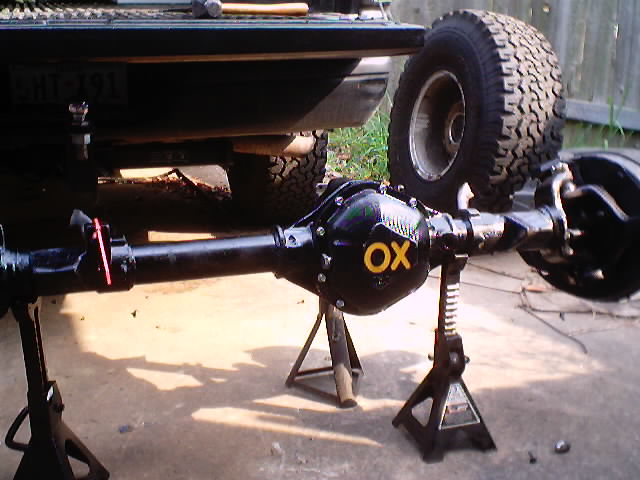
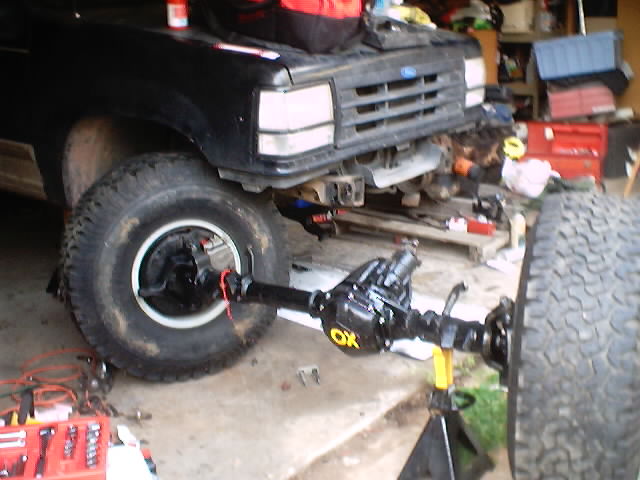
Front Suspension Components: To fit the Dana 44 running gear on the front of the explorer, there are a number of options. The most desirable of these would be to mount a custom fabricated 4-link suspension to allow for maximum articulation. This however, was a little out of my (and many others) price range. Another route is to utilize the stock suspension components from the donor bronco. In particular, I used the radius arms and radius arm brackets for my application. The stock 78-79 radius arm brackets provide plenty of drop for my suspension needs.
I have heard also that a skyjacker extended radius arm crossmember can serve admirably to locate the Bronco radius arms. I used the radius arm brackets to locate the axle on the truck. On the passenger side, The rear upper hole on the radius arm bracket is lined up with the existing bolt from the stock transmission crossmember. On the drivers side, the bottom rear hole on the radius arm brackets needs to be moved forward 1/2" to allow the use of the stock transmission crossmember bolt. The passenger side of the stock transmission crossmember must be modified in order to mount the radius arm bracket. In my case, I bolted a piece of flat stock, 1/4"x4"x6", to the radius arm bracket, cut the transmission crossmember at the appropriate angle, and welded the remaining crossmember to the piece of flat stock.
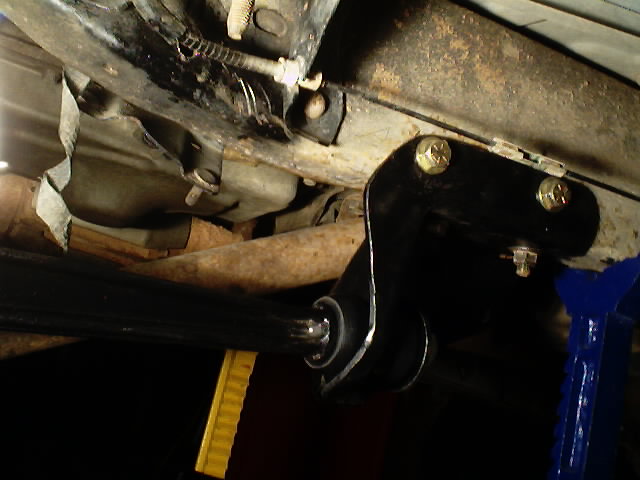
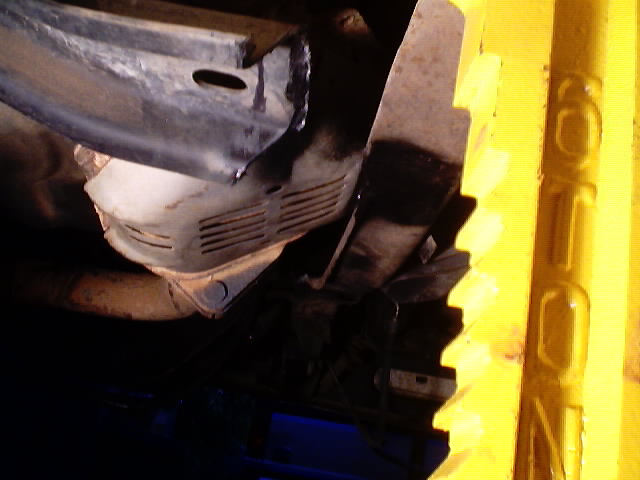
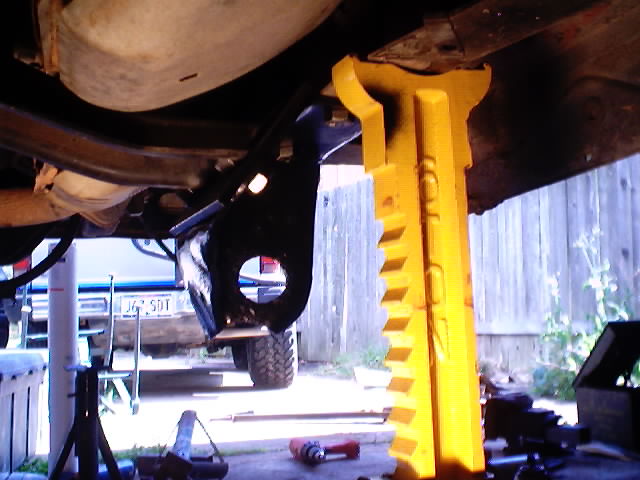
Options for mounting the axle can be done by either adapting the explorer coils to the Bronco axle, or by adapting the upper coil mounts to use Bronco coils. Explorer coils measure 4.75" in diameter, where the Bronco coils measure 5". The explorer coil buckets can be modified to accept the larger Bronco coils, but I chose to instead to mount early Bronco coil buckets. The coils that I used are super soft variable rate Rockcrawler coils from Their intended use is for a 5.5" lift on an Early Bronco, which ends up being around 8" of lift on an Explorer. Other choices that I have seen used include James Duff Early Bronco 3.5" lift coils, which work out to be about 6" of lift on the Explorer. This is about the shortest lift height that I would recommend with this conversion, as engine crossmember clearance then becomes a problem. Mine has not yet made contact with the 5.5" coils, but I will probably be cutting down and reinforcing the engine crossmember in the near future. Since the stock Explorer coil buckets have integrated upper shock mounts, I added longer travel shock mounts that were original equipment on an F250. I ended up going with #1005 5.5” Bronco coils which have a variable spring rate of 375/236lbs.
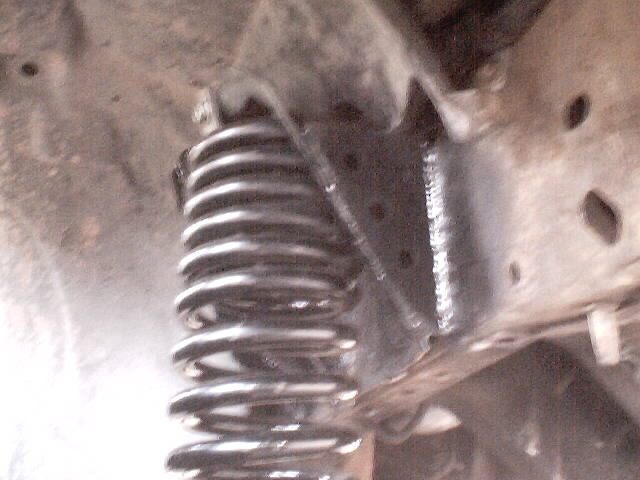

Trackbar, Steering, and Brake Lines: For the trackbar and bracket I used a James Duff trackbar drop bracket reinforced and welded to the frame, and also to the driver's side coil bucket. The trackbar is the stock 79 Bronco trackbar cut down, threaded, bolted and rewelded. The steering linkage is mostly from the 79 Bronco. The tie rod is cut down the same width as the axle, and the drag link was cut and mated to the stock Explorer ball joint to mate it up to the Explorer pitman arm, which is in my case a Superlift drop pitman arm.
The trackbar, draglink, and tie rod were all threaded internally and attached with all-thread before being welded together on the outside. This combination yielded a very close to parallel trackbar to drag link ratio, resulting in unnoticeable bump steer. I plan on eventually doing a tie rod over conversion which would place the tie rod about 4"; higher out of harms way.
To keep the drag link to trackbar angles the same, I will be going back to using the stock (non-drop) pitman arm for the Explorer. For the front brake line, I capped off the stock line that ran to the passenger side TTB arm, and instead routed the stock line to the driver's side TTB arm through the trackbar mount and to a central mounting point on the front differential, before being split off to either front caliper.
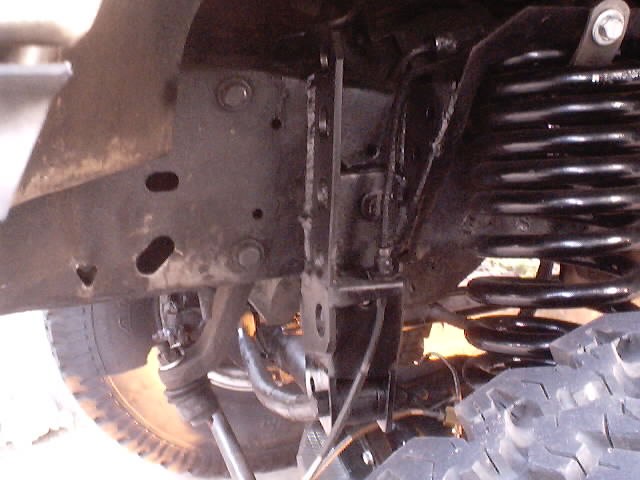
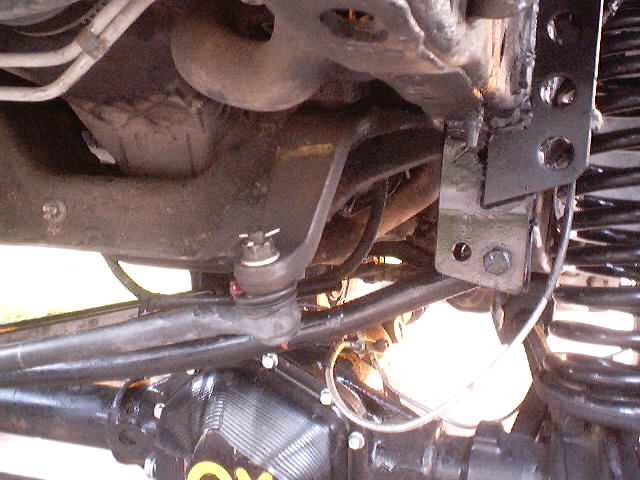
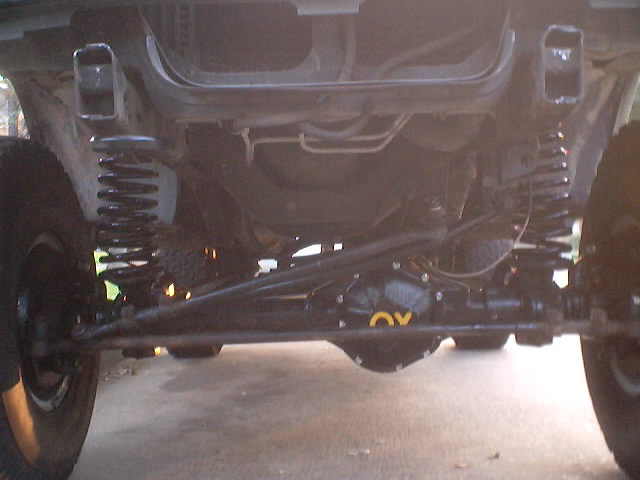
U-Joints and Driveshafts: The stock Dana 44 front axle from a 79 Bronco came equipped with 1350 u-joints. The Explorer driveshaft ends in a 1310 u-joint. Your options here are to run a bastard u-joint, which would basically have two 1310 ends and two 1350 ends, change your driveshaft to accept 1350 u-joints, or swap out the pinion yoke on the Dana 44 for a 1310 version.Thankfully, Jeep rear ended Dana 44's were equipped with a 1310 u-joint yoke which was easily bolted onto the 79 high pinion Dana 44 axle in my application. This was a little more expensive than simply running a bastard u-joint, but, having heard that bastard u-joints are inherently weak, I felt more comfortable going with a more structurally sound u-joint. In addition to the strength factor, a 1310 u-joint would be infinitely more available in the event of trail breakage because of the widespread use of this u-joint in driveshafts in both Jeeps and Explorers. Because the Dana 44 pig, or center section, is larger than the stock Dana 35 counterpart, I shortened the front driveshaft two inches to adjust it to the proper length, and to avoid bottoming out on hard bumps.The rear driveshaft had been previously lengthened to adjust for the old 7" Superlift/warrior shackle lift. The 7 degree C-bushings combined with the drop brackets made for a perfect pinion angle.
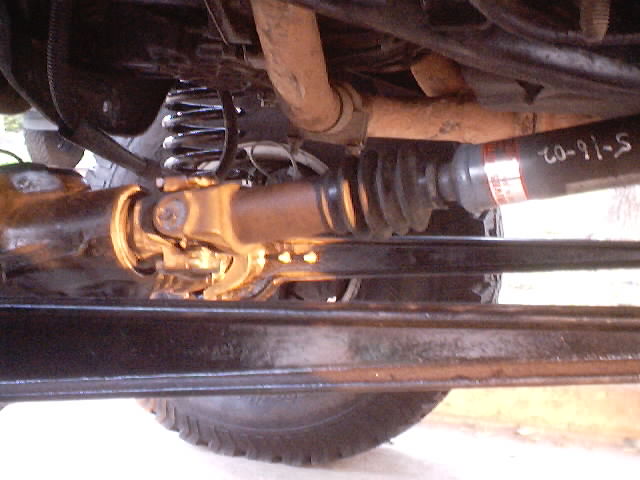
Concerns and Regrets: If I had it to do over again, I probably would have moved the axle further forward at the time of install. I had to trim the rear of the fender just to get the 35's mounted, so I have concerns on whether I'll be able to mount a much larger tire. I would eventually like to go with 38's, and it would have been easier had the axle been mounted a little farther forward.
Parts List: Superlift Drop Pitman arm; James Duff trackbar bracket; Energy Suspension 7 degree C Bushings; Dana 44 solid axle with radius arms, brackets, coil perches; early Bronco coil buckets; F250 Shock towers; Wildhorses4x4 5.5" lift coils, Jeep D44 1310 U-joint yoke; OxLocker, cable, and shifter; 5 on 5.5 wheels, dutchman axle shafts with 5 on 5.5 bolt pattern; Rancho RS9112 shocks front and rear; new brakes, hubs, bearings and races, 4.88 gears, and some brake line material.

